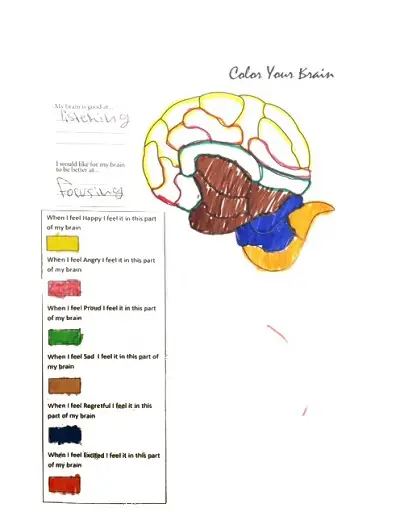Today's post comes from our Therapeutic Group Leader, Taylor Freeman. Taylor created an art activity involving the brain, feelings, and art! What could be better?
**
In my work with teens and pre-teens, I see a lot of kids who come from challenging backgrounds. These kids often have a lot of feelings, but don’t know how to distinguish them or how to process them. Since we do a lot of work with groups, we like to mix up how we talk about our feelings. Sometimes we will sit in a circle and discuss questions. But other times we like to add in fun projects for the kids. This is an art project called “Color Your Brain” that my group uses with 9-12 year olds.
We use the brain because we talk with the kids about how our brains control everything we do, from movement to feelings. This is just another concrete way to remind them about the power of their brain. We provide the students with a brain worksheet (print your own here.)

There are two questions at the top:
“My brain is good at…” and “I would like for my brain to be better at…”
These are linked with the idea of a growth mindset, and we use these to remind the kids that brains can change and grow throughout our whole lives.
Once they answer these two questions, I ask them to set down their pens and close their eyes. Here is what I tell them:
“I want you to think about a time in your life when you felt incredibly happy. Maybe you were spending time with friends or family. Maybe something exciting happened. When you remember that feeling, think about where you notice that emotion in your brain. Allow yourself to smile as you feel happiness in your brain. Take a deep breath. Let it out.
Open your eyes and choose a color for happiness and color in that area of your brain. Once you have finished, set down your crayon and close your eyes again.
Now think about a time when you felt incredibly angry. Once you find that memory, I want you to concentrate on where you feel anger in your brain. Now make a fist with your right hand and squeeze your fist together. Take a deep breath in, and let it out. Relax your fist. Notice how your right hand feels in comparison to your left hand. Now, open your eyes and choose a color for anger. Color in that part of your brain where you feel anger.”
Then we keep going in this same manner. For pride, I ask them to raise both hands in the air above their head as they breathe in. For sadness, I have them cross their arms across their chest and hold on to their shoulder blades. For regret, I have them lower their head until their chin touches their chest. For excitement, I have them clap their hands as fast as they can. All of these are actions most associated with the feeling, so it helps them really put themselves into that emotion.
At the end of the activity, I ask them:
What was easy about this activity?
What was hard about this activity?
What did you notice about yourself?
How will you use what you learned?
You may be thinking that it would be hard to identify where we feel emotions in our brain, and that is true. The point of this exercise is to help kids identify that we have physical reactions to our emotions. Linking it to the brain is really helpful, because it shows the kids that all of these emotions, the good and the bad, are controlled by our brain. And we’ve already worked with them on the idea that we are in control of our brains.
Lastly, as a therapist, it gives me a powerful perspective into a child’s experience. If a child colors a lot of the brain with his color for anger, or regret, or sadness, that gives me a great starting point. Why did you color in so much anger? How do you think we can make it so that more of the brain is filled with happiness?
I think this activity would work great with one kid or a group, and probably a variety of ages. I hope you’ll give it a shot! It’s a good, simple activity where the kids and the therapists can make great progress while still having fun.
Share with
Related Resources